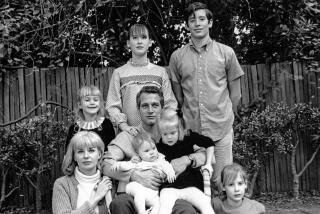A Dancer at the World’s Rim : BLACK EAGLE CHILD: The Facepaint Narratives, <i> By Ray A. Young Bear (University of Iowa Press: $24.95; 304 pp.)</i>
Albert E. Stone, in his foreword to “Black Eagle Child,” calls this book an experimental autobiography. But the reader quickly discovers two things: This tale is not factual--it is full of composite characters and fictionalized events--and it is only tangentially about its author, the Mesquakie Indian poet Ray A. Young Bear, who eventually disappears behind a series of changed names, false leads, alter egos, digressions, epi-stories and myths.
Young Bear is a poet who makes his aesthetic home between two worlds, the native and the non-native. He is a dancer at the world’s rim--a fan dancer, for he conceals as much as he reveals of himself and his people. Concealment is a key aesthetic principle, for as Young Bear constantly reiterates, there is a price to be paid for telling tribal secrets to outsiders. In his afterword to “Black Eagle Child,” he recollects how his grandmother taught him that “there were things I could not write about.”
As an Indian who sets himself up as an author in the white sense, Young Bear is freighted with a terrible dual responsibility: to satisfy his readers that he is being truthful and informative, and to satisfy his personal and tribal need for secrecy. He must invent a new form, the nature of which is duality, a form that is never straightforward, yet full of implication. It will be poetic, but it will not fulfill every demand of traditional poetic genre. It will always be surprising; it may not end. A code, in other words, that only the right people can break.
In his first book of poems, “Winter of the Salamander” (1980), a much younger Ray Young Bear gave a hint of forms to come:
What do you do when
there is a man
who represents your dreams
who goes talking and appraising
his deeds
and for no reason he stops
and says something new
there is a chance
for those who want to learn
but not for those who feel it
hard and difficult
For “those who want to learn,” “Black Eagle Child” is a kind of non-autobiographical Zen treasure trove of non-information about Mesquakie Indians and Young Bear. It is ostensibly a poetic Bildungsroman centered around Edgar Bearchild, a Mesquakie boy from the Black Eagle Child Settlement in central Iowa (Young Bear is from the Mesquakie settlement near Tama, Iowa). It begins with Edgar in grade eight in 1965 and follows him through his career as the community’s youngest treatable alcoholic. There’s a brief stint at a prestigious liberal-arts college in California, then back to Iowa, where he becomes a successful poet haunted by UFOs. He lives off grants from the fictional Maecenas Foundation (Young Bear received grants from the National Endowment for the Arts in the 1970s).
This process of becoming a writer fascinates Edgar, who sees himself wrapped in a paper cocoon, changing, altering, saving himself from the usual fates of a reservation Indian. Learning to translate between worlds redeems him, though with redemption comes alienation and survivor’s guilt, since he must separate himself from the normal communal life of his people.
Twinned with Edgar (like the twin boys of Indian legend) is the more adventurous and traditional Ted Facepaint, who follows the tenets of the Well-Off Man Church, a fictional Mesquakie affiliate of the mushroom-eating, pan-Indian Native American Church. (This, by the way, is Young Bear being highly elusive. Rather than reveal traditional Mesquakie rites and legends, he describes a modern cultural intrusion in which he has no stake. Here he seems to reveal without revealing anything.)
Like Edgar, Facepaint also heads west to college. He drops out and hitchhikes across America, trying to reach some romanticized accommodation with this alien white country, only to be beaten and robbed along the way. Back in Iowa, he continues his frenetic drinking and eventually dies--metaphorically, at least--stabbed repeatedly with a screwdriver by rogue Mesquakies nicknamed the Hyenas. He is then mystically transported to Orion, the sacred constellation of the Well-Off Man Church. “Black Eagle Child” closes, however, with Facepaint’s resurrection at the hands of Rosie Grassleggings, an immensely obese native healer.
Young Bear knits together these two narrative lines with a complex pattern of imagery. Red-haired and red-hatted people relate to the red-capped hallucinogenic mushrooms, and also to the red-haired man of some native legends. White rabbits recall the Great Hare, Nanebojo, an Algonquin culture hero, who is often paired with Jesus Christ in modern native myth.
This is the bare skeleton of Young Bear’s code, the vastly complex and engaging system the reader has to learn to read. Only superficially chaotic, his narrative bears all the indications of a sophisticated and cunning literary intelligence. Young Bear has a novelist’s eye for precise social and atmospheric detail.
In his afterword, the author himself calls his book a collage, but whatever you call it, “Black Eagle Child” is an example of the new blood flowing back into the hardened arteries of Anglo-American literature from the margins--from the formerly colonized, enslaved and defeated peoples who must, inevitably, change us as we have changed them.
More to Read
Sign up for our Book Club newsletter
Get the latest news, events and more from the Los Angeles Times Book Club, and help us get L.A. reading and talking.
You may occasionally receive promotional content from the Los Angeles Times.






